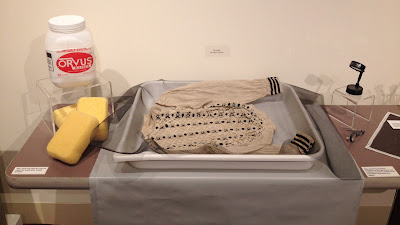Last week I wrote about
THIS article in
American Craft magazine, considering the distinctions between hobbyists and professional craft artists. I described how art historian Carolyn Fowler proposes that the key distinction revolves around whether the craftsperson "engage[s] questions in their work that interest the world of art and craft." Fowler goes on to say that hobbyists may engage different, but
equally valid and interesting questions.
What does it mean to "engage
questions in [craft] work that interest the world of art and craft" though?
That is truly the issue, I believe, and perhaps the clearest distinction
between those who can be called serious craftspeople and those
who may simply enjoy keeping their hands busy while they watch TV.
Not that there's anything wrong with that! Lest you think I am an anti-hobbyist snob, let me point out that
the bed quilt I am currently making
is reserved for stitching on in front of the TV. While I designed it
myself (not in front of the TV!), I have adapted the motifs from other
sources (Turkish tiles), and it follows all the rules of a conventional
quilt: made to be used on a bed, comprised of three layers stitched
together, made of commercially produced printed cottons and constructed
by conventional applique and piecing. It is not innovative; there is
nothing at all about it that would "interest the world of art and craft"
but this project offers pleasure in the making, personal meaning and
utility for me. And for this project, that is enough.
 |
| sketch for Iznik tile-inspired bed quilt |
And
yet I consider myself a serious, professional crafts maker as well. I was flabbergasted that I sold nearly all of my fall/winter inventory of handwoven wearables this year!
Perhaps a person can be both a hobbyist, on certain occasions or for
certain projects, and a professional craft artist, in other contexts or mediums, at the
same time? Perhaps one distinction between hobby work and professional
work is that the aim of the former is personal pleasure, utility, and
meaning, while the aim of the latter may incorporate all those but also seek to engage a wider audience. For
the hobbyist, the point is to experience the joy of working with one's
hands, with materials one enjoys, to hone one's skills and to make
something useful and meaningful for one's home or for gifts for friends
and family--all valid and satisfying intentions. The professional does all those things but is making work
designed for a wider audience, in full awareness of other work, past and
present, that has been done in her
medium.
When I weave scarves, shawls and wraps for sale, I am thinking
not of my own favorite colors, but of colors that are current, popular,
and versatile with most women's wardrobes. I am thinking of
designs that women of varied body shapes and sizes can wear in daily life. I am
thinking of how my pieces can be unique, special luxury items that are
nonetheless affordable. I am thinking of what I can accomplish on my loom, with
my skills, using materials that I can easily obtain. But this work still does not "engage questions that interest the world of art and
craft," because it is responding to
what is rather than
what could be. It is essentially practical, traditional and market-based.
 |
| tencel infinity wrap |
Two weeks ago I visited the
Iris van Herpen exhibit currently at the High Museum.
It is a mind-boggling show of what is possible in fashion for someone
who not only thinks outside the box, but doesn't seem to have ever
encountered the box to begin with! Iris van Herpen, a young Dutch
designer, addresses the supreme question that engages the contemporary
world of art and craft--how to
make it new. She makes work
using materials, structures, and processes that to my knowledge have never been used in
fashion before. Her designs are inspired by new information gleaned
from science and technology. In my view her designs are sculptures that happen to hang on a
woman's body, rather than clothes a woman can wear in daily life. This is craft
raised to the level of art because it engages a very old question--how to
cover the body--in startlingly original ways that acknowledge the contemporary world of ideas. Van Herpen's work makes fashion truly new.
 |
| Chemical
Crows, Skirt, Collar, January 2008; Ribs of children's umbrella,
industrial boat filament yarns, cow leather, and metal eyelets. Image
courtesy of High Museum website. |
|
In my own studio, I do attempt to engage questions of interest to the wider
world of art and craft when I design and weave
tapestry. I am attempting to make it new, not by
innovations in tapestry technique or materials (yet), but by exploring very old themes and subject matter in a
contemporary context. One question I am engaging is "Can anything meaningful to contemporary viewers possibly be said about the Virgin Mary in the medium of tapestry?" It is too soon to say. For me now, the attempt is utterly absorbing.
The important thing, I think, is to be aware of what you are about, what your intentions are, when you engage in making. Whether you consider
yourself a hobbyist or a
professional, what questions are you engaging? Do you see yourself moving fluidly between categories, or firmly in one camp or the other? How is your approach to your work influenced by how you define yourself? Deep questions! Feel free to share in the comments below.



















































